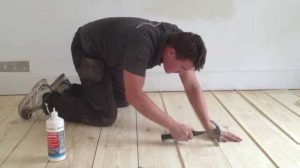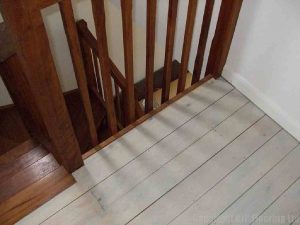There are many factors to consider when choosing between having your hardwood floors replaced or refinished, such as the condition of the floor, your budget, and so on. In this article, we’ll cover what you should consider before choosing one over the other.
Things to Consider
Time Refinishing a floor takes more time because there are a lot of processes involved. The furniture in the room will have to be removed, the wood sanded bare, and in some instances, structural or cosmetic repair done before a stain or lacquer can be applied. When all of this is happening, the room cannot be used.
Aesthetics
If brighter-looking floors are what you are going for, refinishing is the best way to restore their original shine. However, if you would like to change some features of the floor itself, like the direction of the planks, the type of wood, or the consistency of the material, you will need to go for a complete replacement.
Age
The age of your floor is also an important factor to consider. If your floor has been in place for decades, it may need to be replaced and not refinished for a number of reasons. For example, you will need to replace your floor if it has already been refinished several times or has cracked between the planks. In our experience, it is best to have very old floors replaced.
Allergies
A hardwood floor is allergenic because dust mites and pollen can’t bore deep into its recesses, which is a regular occurrence with a carpet’s thick fibers. It’s also really easy to keep clean with just a quick sweep using a hard-surface vacuum, broom, or Swiffer-type mop that quickly gathers up dust and dirt. If your hardwood floor is currently covered by a carpet, it most likely will not have a lot of wear and tear; in this case, refinishing it would be the more cost-effective option.
Water Damage
A telltale sign of a floor that has suffered from water damaged is the separation or cupping of some of the boards and the presence of dark areas. If the floorboards are only cupping slightly, this can be fixed with a little sanding and refinishing. However, if the separation is major or there are entire boards that have turned black, you will have to have the entire board or some sections replaced.
Price
If the cost of the project is a major concern for you, you’ll be better off choosing a refinishing job. Refinishing a hardwood floor is much cheaper than replacing hardwood flooring (even if it’s done with cheaper material) because the only material you are going to be paying for is the product used to treat the wood.
Repairs
As difficult as this might be to do, take a close look at your floor. Is the damage really that bad? A lot of the time, a hardwood floor isn’t seriously damaged. It just looks that way because of years of improper cleaning methods and heavy foot traffic. If this is the case, a little TLC in the form of refinishing will be all you need to bring your floor back to life.
When to Refinish a Hardwood Floor
Worn or Splintering Areas Hardwood floors are susceptible to wear and tear as they age; if you have areas where the wood looks worn and you can visibly see that the stain is off, it’s time to have your floors refinished. If you continue using it, as is, the wood will begin to splinter which can lead to injuries and make the cost of the entire project more expensive.
The presence of grey boards
When the polyurethane coat used to finish your floor wears off, the wood begins to absorb water. This water can come from snow, rain, pet’s paws, spilled drinks, and even the cleaning product used on the floor. When your floorboards turn grey, it is your floor’s way of crying out for help; it is a sure-fire sign that it is time to have it refinished, and the sooner, the better!
Sticking Rugs
If your rugs begin sticking to your wooden floor, it is definitely time for refinishing. Sticky rugs are a sign that your floor is worn out in certain places, and this needs to be corrected quickly.
Warping
Moisture also warps wood. You may notice some separation between the planks. The edges of the boards may buckle upward or turn downward. Any of these signs mean it’s time to refinish, and your contractor may recommend replacing damaged slats.
You Want a Change
Getting your floors refinished doesn’t always have to be about repairing the damage. It’s a great way to give your floors a new stain. If you are looking to spruce things up, refinishing your floor will allow you to get a fresh-looking floor without having the floorboards replaced. This is especially useful if your hardwood floor is in good condition, but the style is outdated. Refinishing it with a different stain is an easy way to upgrade your floor. Doing this will immediately give your home a face-lift. Not only is this option more affordable, but it will also increase the resale value of your house because the original wood flooring is intact.
When to Replace a Hardwood Floor
Loose Floorboards
Does your wooden flooring bend, shift, sway, or buckle under your weight? If it does, it is time to replace those floorboards or that section at the very least. Although some floor movement can be subtle, you can test the extent of the damage by using something sturdy to check for saggy, floating weak spots in the floors. Still not sure what the root cause of these issues might be? Call a professional. It could be something as major as foundation cracks or water damage, and only a specialist will be able to tell.
Deep scratch marks
If there are chips or deep scratch marks on your floor and the puts are deep, replacing the boards is the only way to get rid of this problem. This is because you can’t sand them down.
Water damage
Flooding can damage a floor beyond repair. When there is water damage, it could cause the wood to warp, bulge, or buckle, making the floor unsafe. The good news is, if it is only some of the floor that has been damaged, you can have some of the boards replaced as opposed to the entire floor. However, if the damage is deeper than the surface, a full floor replacement might be best.
Multiple Refinishing
If you’ve had your hardwood floors for a while, there is a probability that it has been refinished a couple of times already. If this is the case, do well with another refinishing. Refinishing can only be done a couple of times before the wood becomes too thin to support its normal load. If this is the case, replacing the floor will be the best thing to do.
Bugs and Pests
The only way to treat hardwood floors that have become infested is to replace them as soon as possible in order to prevent the spread of those ghastly critters. Although insects like termites are the sure death of hardwood floors, the presence of any insect is an indicator that you need new floors.
Permanent Staining
Hardwood floors can become permanently stained by things like wine, juice, and paint. If the spills are treated immediately, most hardwood floor staining can be avoided. However, over time you might notice a deep-set stain that does not fade or disappear after your hardwood floors have been cleaned or refinished several times. This means it is beyond repair and time for a change.
Costs of Installing New Hardwood Floors
In most cases, it will be less expensive to refinish your hardwood floors. Having them replaced requires you to pay for additional wood and the removal of your current hardwood floor. However, if only portions of your hardwood floor are damaged, you can replace those sections and save a lot of money on the overall cost of repairs. Of course, some old floors will be beyond repair. Floors with a lot of movement between boards are not good options for refinishing because the movement will adversely affect the sanding and finishing process.











